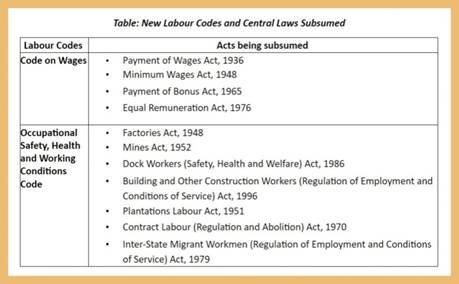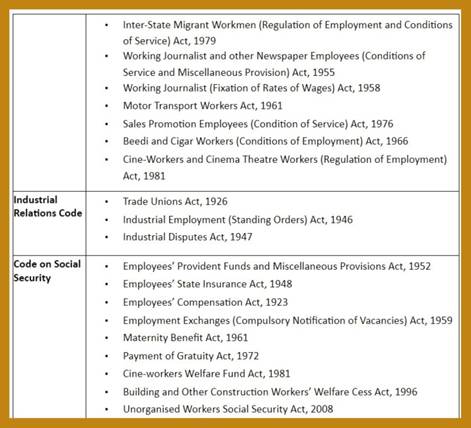Description

Disclaimer: Copyright infringement not intended.
Context
- A two-day meeting of Labour Ministers and Labour Secretaries of States and Union Territories, will discuss the framing of rules under the four Labour Codes.
- The meet has been organized to iron out differences on Labour Codes and evolve a consensus so they could be implemented “as soon as possible”.
Labour
- Labour falls under the Concurrent List of the Constitution. Therefore, both Parliament and state legislatures can make laws regulating labour.
- To improve ease of compliance and ensure uniformity in labour laws the Second National Commission on Labour (2002) recommended the consolidation of central labour laws into broader groups such as: (i) industrial relations, (ii) wages, (iii) social security, (iv) safety, and (v) welfare and working conditions.
- Accordingly the Government notified new Labour Codes.

Subsumed Labour Codes


NEW LABOUR CODES
The four labour codes -- the Code on Wages, Industrial Relations Code, Social Security Code and the Occupational Safety, Health and Working Conditions Code -- are set to replace 29 labour laws.
Code on Wages
- The Code on Wages, applies to all establishments and to all employees in both organised and unorganised sectors.
- This code envisages uniform applicability of the provisions of timely payment of wages and minimum wages to all employees.
- It introduces the concept of a floor wage, which is to be determined by the Centre after taking into account the minimum living standards of workers which may be different for different geographical areas.
- The state government can, under no circumstance, fix a minimum wage rate which is lower than the floor rate determined by the Centre.
- The code also prohibits discrimination between wages payable to a male and a female for the same work done.
The Code on Social Security
- It subsumes nine laws and empowers the Centre to notify various social security schemes like the EPF, EPS and ESI for the benefit of workers in all sectors.
- It also empowers the Centre to frame any other schemes for the self-employed, unorganised workers, gig workers and platform workers and the members of their families.
- Firms employing more than 20 workers have to mandatorily report vacancies online under this code.
- The Code has provision for the creation of a social security fund for workers in the unorganized sector.
- According to some reports, employees may be able to enjoy a four-day workweek provided the total working hours in the entire week is not less than 48 hours.
The Code on Industrial Relations
- It amalgamates three existing laws and expands the definition of worker to include persons employed in a skilled or unskilled, manual, technical, operational and clerical capacity.
- Besides, persons employed in a supervisory capacity and earning less than Rs. 18,000 per month have been brought under the definition.
- The code introduces a new provision for fixed term employment, giving employers flexibility to engage a worker on the basis of a written contract. Fixed term employees will get the same benefits as the permanent employees.
- The new industrial relation code would also improve ease of doing business by allowing firms with up to 300 workers to go ahead for lay-offs, retrenchment and closure without government permission.
- At present all firms with up to 100 employees are exempted from government permission for lay-off, retrenchment and closure.
The Occupational Safety, Health And Working Conditions (OSH) Code
- It amalgamates 13 existing labour laws and applies to factories having at least 20 workers if the manufacturing process is being carried on with the aid of power and 40 if the manufacturing process is being done without power.
- Under this code, employers are required to ensure that the workplace is free from hazards which cause injury or occupational disease to the employees, provide free annual health examination or test, free of costs to certain classes of employees.
- A provision has been made for employers to provide travelling allowance annually to an inter-state migrant worker for undertaking a to-and-fro journey to his native place.
- Further, providing appointment letters to the workers has been made mandatory.
Read about the Labour Codes in detail here: https://www.iasgyan.in/blogs/new-labour-codes-decoded
https://epaper.thehindu.com/Home/ShareArticle?OrgId=GAIA6F82C.1&imageview=0

















